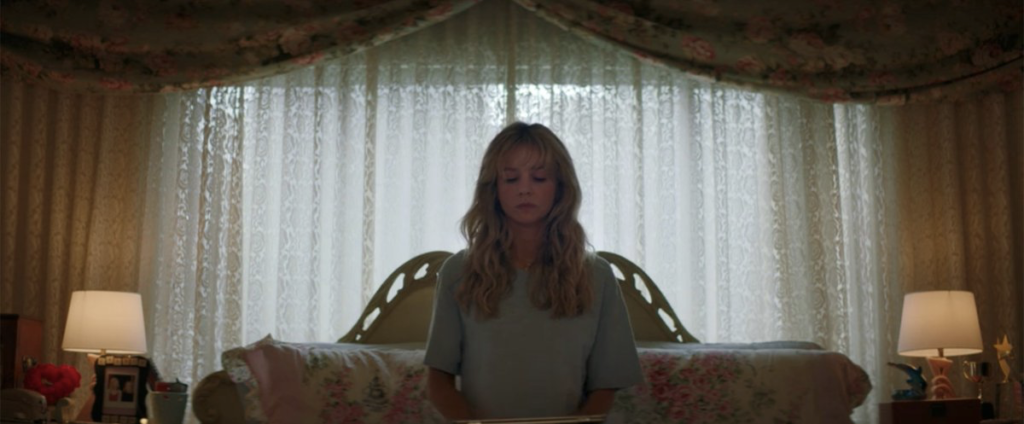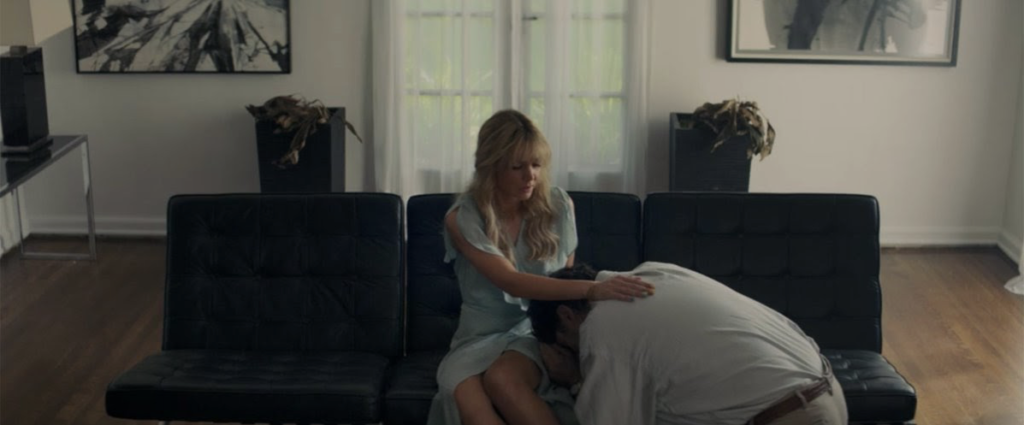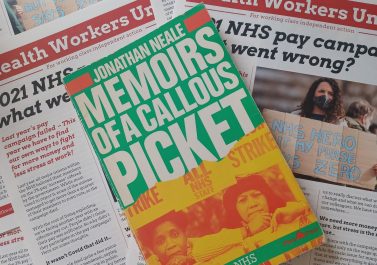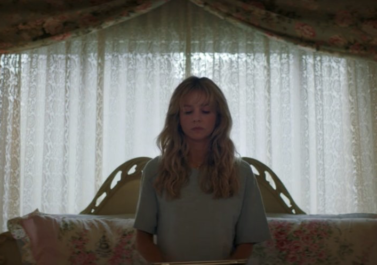
This Review Contains Spoilers: The victim dies
AngryWorkers sometimes watch films – the following comprehensive review was sent to us by comrade Amy Palmer. The review emphasises how in many recent films the reaction to social structures of oppression is reduced to individual acts. We could add that collective reactions, on the other hand, are more often than not depicted as semi-fascist mob violence, e.g. in the recent Mexican film ‘New Order’ or even ‘Joker’. We will have to re-discover collectivity and freedom elsewhere…
When films that claim to criticise the status quo win big at the Oscars, it’s a sure sign that something is up. It also means we should go and see them. The frustrating job of watching these films will tell us very little about the struggles they claim to represent, but will give us a lot of clues about the way those same struggles are captured. If you haven’t watched Promising Young Woman and Two Distant Strangers already, then I’ve done the hard work for you, showing that, for all Hollywood’s emotional speeches, these films reinforce exactly that which they claim to be holding to account.
There is something particularly unsatisfying about Promising Young Woman. Just as the “promising” of the title already hints at the young woman’s failure, the film’s claims to be a “revenge thriller” that “holds society to account” fall flat. But perhaps this double failure inadvertently tells a truth. The protagonist’s repeated and unfulfilling affirmation of trauma, and the film’s complete inability to thrill, reflect the impotence of the dominant political discourse on the subject, which does nothing more than repeatedly reaffirm our victimhood.
If you haven’t seen it, the film goes something like this: the protagonist, Cassandra, avenges her friend’s rape and subsequent death by repeatedly going to clubs, pretending to be very drunk, and then, when some “nice guy” takes her home and starts to have sex with her, confronting them, which involves her pointing out that they were about to rape her and them trying to deny it. There is also an implication (a red mark in a notebook) that she engages in some act of violence against some of them, although it is never shown.
A similar repetition of trauma can also be found in another 2021 Oscar winner, Two Distant Strangers. This Netflix short tells the story of a young black man, Carter James, who is stuck in a Groundhog Day type loop, in which he is repeatedly killed in different ways by the same white cop, and repeatedly wakes up again in the same morning, trying to work out new ways to outwit the white cop, only to be killed again, and again, and again.
In the last ten years, more people talk about rape and more people talk about racist police brutality. This is not because there are more rapes or more racist police violence, but because people are refusing to stay silent. However, the dominant discourse encourages us to stop there. The silent victim can, even should, become a victim with a voice, but they must remain a victim: they must use their voice to reaffirm their victimhood. So just as asylum seekers are forced to speak of their trauma in order to gain citizenship, we are asked to recount our traumas in order to be recognized. Our traumas must be told publicly and once they are told they must define us. This culture has become so predominant that even individuals who already have their fair share of recognition (politicians, academics, celebrities etc) now feel the need to list their traumas after their names on their social media profiles: if you haven’t got a PhD you better have PTSD. In a world divided into goodies and baddies, victims and perpetrators, abused and abusers, we must demonstrate we’re on the side of the abused. This is what Asad Haider calls, “the logic of the victim”, in which the goal is only “the recognition of your injury” and “is fundamentally about state protection and not agency”.
I want to argue that the remarkable similarities between these two Oscar winners are no coincidence. They are united by the logic of the victim: they boil it down to its essentials and take it to its inevitable conclusion.
The loop of victimhood

The most obvious trope that these films share is repetition, an endless loop of trauma from which the victim cannot escape, and thus in which they remain a victim. In the first, the repetition is driven by Cassandra’s compulsion to replay her friend’s rape by meeting a new potential rapist each week. And although she is not literally stuck in the same day, she seems to be stuck in the past in which her friend’s rape happened: wearing childish pastels, listening to nostalgic pre-crisis pop, she holds on to the lost promise of better days. In the second film we see instead the literal repetition of the same day, an infinite and terrifying loop from which there seems to be no escape. Although both films claim to be saying something about the present moment, these incessant repetitions of extreme traumatic events look more like a social media newsfeed than anyone’s actual lives.
The implication is that these traumatic loops are produced by racism or sexism. The protagonists, Cassandra and Carter, would be doing just fine under capitalism if it weren’t for racism/sexism. Cassandra was a “promising young woman”, the best in her class at medical school, who says she could be living the good life if she wanted to: her friend’s rape is all that has stopped her from fulfilling her promise. Meanwhile, the director of Two Distant Strangers insists we don’t know the background of Carter, we just know that he is a black man. In fact this is not the case at all, we know that he is a graphic designer with an expensive looking apartment and an expensive looking dog. Indeed, the character himself says that he is not only more intelligent, better looking and faster than the cop, but probably has more money than him. Although the director implies that Carter can stand in for every black man, in fact his biography does not reflect those of the majority of black people killed by the police in the USA. By choosing a protagonist who is otherwise well-off, race is isolated as the only problem. To reinforce this, Carter says “the only people who are happy to see cops are white people and other cops”, as if the line between hating or loving the police were purely drawn on race lines.
Not only do the biographies of the protagonists represent an attempt to completely disconnect racism and sexism from class, but racism and sexism are portrayed as a series of extremely traumatic events rather than as insidious daily realities. For example, we do not see the police harassment many young black men experience daily, but only their murder by the police. We do not see how sexism plays out in a woman’s other intimate relationships (where incidentally, most rapes also happen), but only her rape by a stranger. And certainly in neither film do we see the way gender and race are materially grounded, the racialised and gendered structures of the division of labour.
Not only the goodies but also the baddies are decontextualized. They are two dimensional caricatures of prejudiced and ignorant individuals who adhere to a pervasive sick culture which entails wielding power over a specific group of people – rape culture and white supremacy. Any interest in exploring the material realities that underlie and support these “cultures” is completely lacking. Thus the only real explanation we get for these traumatic events is that the baddies are bad.
Any possible violence by the victims against these bad individuals is never realised. Carter refuses the use of his girlfriend’s gun and Cassandra’s violence against men is never seen, so, for the viewer at least (and, we imagine, maybe also for her), it remains a fantasy. Both aim to talk the bad people out of their bad ways, but neither succeeds. At a certain point it seems Carter has convinced the cop to take him home, but then the cop reveals that he too is stuck in the same loop and is willingly killing him over and over again. He is consciously playing the villain and is thus irredeemable. He laughs while he shoots Carter dead on his doorstep. Cassandra meanwhile seems to have very little success in getting “nice guys” to admit that they are not so nice (although strangely they are nice enough that they always stop trying to rape her when they discover she’s sober, implying, completely wrongly, that sober women don’t get raped). And when she confronts her friend’s rapist directly, and for the first time it seems she is about to openly commit an act of violence, she is overpowered by him and suffocated. She becomes the victim again, as she was always destined to be (after all, she’s called Cassandra, doomed to speak but the truth but never be believed). Although we see no violence committed by Cassandra we are shown the whole two and half minutes of her death in real time: how easy it is to kill a woman. Dressed as a sex worker dressed as a nurse, the ultimate woman – both sex object and carer – her body is laid out like Jesus on the cross, dying for your sins. Meanwhile, Carter’s body bleeds a map of Africa. The implication is that, as woman/black man, they were already doomed to die at the hands of bad men. The latter film ends with a list of black people killed by the police and the song Just the way it is. “Some things will never change”.
The law as the only way out?

Cassandra and Carter’s violence is inadequate if it exists at all, and their attempts at education get nowhere. And so, if justice is to be done, both Cassandra and Carter will ultimately need some third party intervention. In Promising Young Woman it is telling that out of all the men she approaches it is only the lawyer in her friend’s rape case who asks for forgiveness and is thus forgiven: whereas bad men cannot be changed, the law is essentially moral. The lawyer is also left with the responsibility of seeing that justice is done. While her body is burnt, the killer is arrested. She might have been reduced to a pile of ash, her victimhood almost comically reaffirmed, but she has the moral high ground and the law on her side. Although it might seem counterintuitive to say that Two Distant Strangers, in which the villain is a cop, is also calling for the intervention of the law, this is really the only way out the film can be seen to propose. As one critic put it, “the filmmakers suggest that this isn’t a problem that Carter, or any victims in such cases for that matter, can fix. He tried everything, but it’s up to those in power to find a solution and spare black lives. They are the only ones truly capable of ensuring no more names are added to the list of victims.” The message is that all black people can do is keep getting killed and getting back up again while they wait for “those in power” to clamp down on racist cops, improve the law and thus break the loop.
Although both directors claim to be saying something for all women or for all black men, they focus only on one individual. They are either suggesting that each woman and black man are acting alone, at best recreating the imaginary collective of social media, made up of the sum of individuals, or they are using individual experiences as a metaphor for collective struggle, and thus reducing the power of the collective to the impotence of the individual. Either way, they are ignoring the power of collective struggle to break loops. In doing so perhaps they are reflecting an ugly truth about the current moment. For example, the burning of cities after George Floyd’s murder was a short lived but real refusal of victimhood, an attempt to break the loop. But the social media storm that followed substituted that struggle with individual stories, hashtags and requests to those in power, ensuring that the loop kept turning, but now with the illusion that it was being turned by the victims themselves.
Why do we let this happen? Is it simply that our collective struggles aren’t strong enough? Or are we as individuals really so tempted by the promise of recognition that social media might give us, that we willingly return to the familiarity and powerlessness of the victim, so perfectly expressed in these films? And if this is the case, would it be better if women and black people stopped talking about rape and police violence? Are individuals confronting their trauma just delicate snowflakes who weaken the possibility of class struggle? Of course not. As much as we must ask how and why the dominant discourse seems to be capable of smothering collective struggle through the endless reproposition of the traumatised individual, and the endless division of individuals on the basis of their particular traumas, these films severely underestimate not only the power of the collective but also of most individuals confronting trauma. If all the one in three women who have suffered physical or sexual violence or the three in ten black Americans who have been on the receiving end of police violence shared the destiny of Cassandra and Carter there wouldn’t be many of us left. But, in fact, a world of individual victims completely destroyed and defined by their victimhood is nothing more than a Hollywood fantasy.
We May Destroy You

The TV series I May Destroy You, based on Michaela Cole’s own experiences of rape, explores the damaging role of social media and its “echo chamber” of “pain and frustration”. At one point the protagonist takes on the role of a kind of social media super victim, the “consoler of the weak and avenger of the bad men”, enjoying the power and recognition that this gives her. But ultimately she rejects the violent simplifications of social media through exploring the relationship between herself, her rape, her rapist and those around her and the context and contradictions that allowed it to happen. Far from being decontextualised, trauma often forces you into a deep confrontation with your context, a confrontation that, instead of defining you, forces you to call into question your isolation, deepening your understanding of what produced the trauma and thus the possibility and the will to fight it.
This acknowledgement of, and confrontation with, her victimhood, ultimately means she changes from the object of the title – the destroyed – into its subject – the potential destroyer: “I’ve gone underneath, underneath into the darkness, and that darkness is now in me, looking at you, so I might seem a little bit more frightening than the last time you saw me.”
Although this process is individual and not collective, and although not all individuals will go through it, these many individual struggles should not be dismissed as irrelevant to class struggle. I would go so far as to say that if there is to be a new class struggle, it will not be led by those who remain silent or want others to remain silent, or by Carters and Cassandras reaffirming their victimhood, but by the ever increasing numbers of those who have acknowledged, confronted and ultimately refused their victimhood and are ready to fight against the whole system that tries to force them into accepting it.



